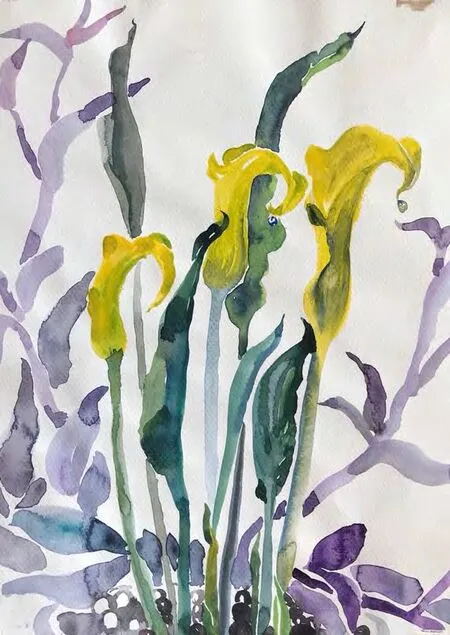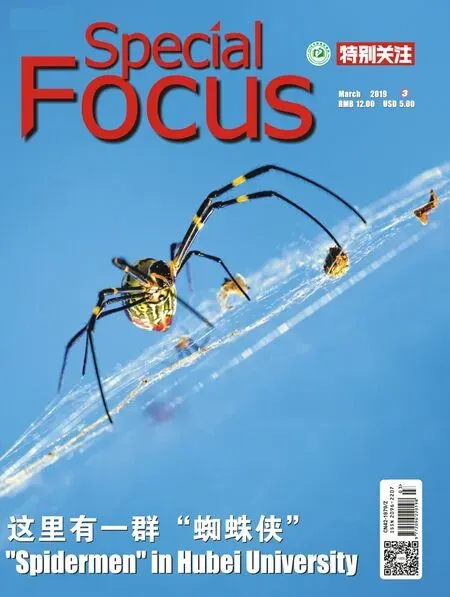Ouyang Lisha and Her Watercolor Paintings
Text by Zhao Mengchen & Tang lin Photos by Su Zhuolin
Upon entering Ouyang Lisha's studio, we were immediately impressed by the bright colors, smooth lines, and appealing artistic effects fully displayed by her watercolor paintings. The traditional Chinese artistic elements she melted in Western-style watercolor paintings creates a unique artistic style with a blend of Western and Chinese characteristics.
Even as a child, Ouyang Lisha had a great gift for drawing. When she was three, her father found that she was skillful at drawing smooth lines and then sent her to learn Chinese painting. She began practicing sketching when she was six and at the age of 14, she became a student at the High School Affiliated with the Hubei Institute of Fine Arts, learning painting from Chen Yunquan,a master of Chinese traditional painting, as well as from Liu Shouxiang, who was renowned for his watercolor paintings. Thanks to her teachers' strict instruction, Lisha learned various painting skills, which laid foundation for her future painting career.
“My painting techniques, aesthetic preference and artistic accomplishment were all reared and nourished in China,” said Ouyang Lisha.
Ouyang Lisha's biggest inspiration was her five-yearlong overseas study in Germany where she studied at the Münster University of Applied Sciences for her Master's degree from 2000 to 2005. Germany is an ideal country for artists, with its outstanding architecture and landscapes everywhere, as well as plenty of artistic resources and art exhibitions. All these characteristics offered Ouyang Lisha imaginative room for painting. Her German mentor, Professor Hartmut Brückner, a first-class artist and designer in Germany, has won the title of “the most beautiful book design in the world” in 2004, the crowning achievement in the field of book design in Germany. And according to Lisha, “It was Professor Brückner who inspired my creativity and encouraged me to innovate. ”
“Traditional Chinese painting is totally different from the German style. Chinese artists prefer spontaneity in drawing, emphasizing the coherence between the brush move and mental flow, while German painters praise the accuracy of the painting.” Two different genres are skillfully blended in Lisha's artworks.
In her watercolor painting Spiderworts and Three Callas, three blooming callas stand in the center with their stems paralleling in an orderly manner, while the exuberant leaves and spiderworts strive to break down the shackles, reflecting the harmony between order and vitality.
Ouyang Lisha is meticulous about the colors in her paintings. Although most of the traditional Chinese and watercolor paintings are a light hue, Lisha tends to apply colors in sharp contrast. In the above painting, for example, the vitality of callas is shown through a strong visual effect posed by the contrast between the neon yellow and light purple.
Not only are Ouyang Lisha's paintings greatly influenced by both Chinese and Western cultures, but she holds a supportive attitude towards cultural inheritance and cultural exchange.

欧阳丽莎画作 Paintings by Ouyang Lisha
“I have seen many Germans who practice traditional Chinese acupuncture to treat their illnesses and relieve pain. It seems that some Germans have done better in preserving traditional Chinese medical skills than Chinese ourselves, so I ponder what we Chinese artists can do to make our culture more prosperous.
That's why Ouyang Lisha published her bilingual book (in Chinese and English)—The World of Black and White, showcasing the magic and charm of Chinese Calligraphy to the world. Different from a traditional Chinese book on calligraphy, Lisha designed her book in the form of traditional Chinese concertina binding, which well explains the structure of Chinese characters and skills of brush calligraphy, as well as cultural connotations behind them.
In the future, Lisha expects to have more opportunities to introduce Chinese art to the world and improve cultural exchange and mutual understanding between Chinese and Western culture through her works.
走近欧阳丽莎
文/赵梦晨 唐琳 摄影/苏卓琳
绚丽的色彩、流畅的笔法和呼之欲出的艺术表现力,是欧阳丽莎画室中的水彩作品带给我的第一印象。在她笔下,水彩这一西洋画种融入了中国画的写意元素,营造出中西结合的独特画风。
欧阳丽莎从小便显现出过人的绘画天赋。3岁时,父亲发现她随意勾勒的线条非常漂亮,于是带她学习国画;6岁,欧阳丽莎开始学习素描;14岁进入湖北美术学院附中后,在工笔花鸟大家陈运权老师以及以静物水彩闻名的刘寿祥老师等名家的引领下,欧阳丽莎广泛涉猎不同画种,奠定了坚实的绘画基础,她直言:“我的技巧,我的审美,以及我的艺术修养,都是在国内学到的。”
而真正为欧阳丽莎打开创作灵感大门的,则是留学德国五年的那段经历。2000年,欧阳丽莎赴德国留学,在明斯特应用科学大学艺术系攻读视觉信息设计硕士学位。德国是艺术的天堂,走在马路上,随处可见让人眼前一亮的的设计和建筑,为欧阳丽莎的艺术创造提供参考。德国丰富的画展与艺术资源也让她得以近距离欣赏大师的技法,从大师笔下汲取灵感。


欧阳丽莎(中)和她的德国导师(左) Ouyang Lisha (middle) and her German mentor Professor Hartmut Brückner (left)

欧阳丽莎画作《冬日马蹄莲》Callas in Winter by Ouyang Lisha
更令她念念不忘的,是其导师,德国艺术设计大师哈特穆特·布吕克勒的指引。2004年,布吕克勒教授的设计作品曾获得德国“世界最美的书”这一书籍艺术设计领域的最高荣誉。欧阳丽莎感叹:“我必须感谢我的导师,是他启发了我的创造力,鼓励我勇敢创作。”
“中德艺术创作方法大相径庭。中国画家挥毫泼墨,讲求一气呵成,德国画家推崇精确细致美。”这两种迥然不同的风格在丽莎的画作中完美交融。
《紫鸭跖草和三朵马蹄莲》画的是盛开的马蹄莲,三朵马蹄莲伫立在纸张中央,笔挺的茎平行而立,充满秩序感,而周围相互叠加的绿叶和自由生长的紫鸭跖草则是为了挣脱桎梏,使秩序与生动相得益彰。
欧阳丽莎在用色上也十分讲究。传统的国画和一般水彩画给人的第一印象都是淡雅。可丽莎的画作却绚丽鲜艳,对比强烈。就像在这幅画中,芥末黄和淡紫的对比带来更大的视觉冲击力,使花朵的生命力跃然纸上。
中西文化对欧阳丽莎的深远影响不仅体现在她的绘画作品上,还体现在她支持文化传承、文化交流的态度上。
“在德国,我曾见过那里的人们运用中医的针灸治病、止痛,有些德国人对中国传统医术的保护和传承甚至比我们中国人自己做得都要好。我就在想,中国艺术人还能做些什么,将我们的文化发扬光大。”
在这样的思考之下,欧阳丽莎制作了中英双语书——《黑与白的世界》,以向世界展示中国毛笔书法的魅力。与普通毛笔字帖不同,这本著作采用中国传统的经折装,从外国读者的角度出发,清楚地讲解了汉字结构、运笔技巧以及其背后的文化内涵。

欧阳丽莎在画室作画 Ouyang Lisha painting in her studio

《紫鸭拓草和三朵马蹄莲》 Spiderworts and Three Callas by Ouyang Lisha
未来,欧阳丽莎希望能有更多机会,借助自己的艺术作品,向世界展示中国艺术,促进中西艺术文化交流、互鉴。

